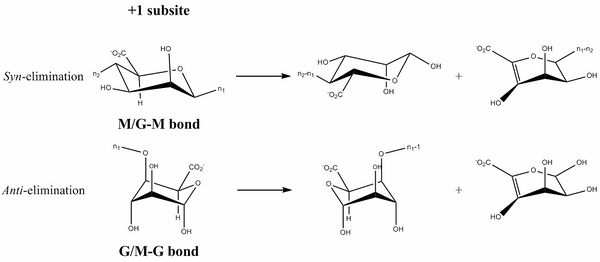CAZypedia needs your help! We have many unassigned GH, PL, CE, AA, GT, and CBM pages in need of Authors and Responsible Curators.
Scientists at all career stages, including students, are welcome to contribute to CAZypedia. Read more here, and in the 10th anniversary article in Glycobiology.
New to the CAZy classification? Read this first.
*
Consider attending the 15th Carbohydrate Bioengineering Meeting in Ghent, 5-8 May 2024.
Polysaccharide Lyase Family 6
This page is currently under construction. This means that the Responsible Curator has deemed that the page's content is not quite up to CAZypedia's standards for full public consumption. All information should be considered to be under revision and may be subject to major changes.
- Author: ^^^Emil Stender^^^
- Responsible Curator: ^^^Birte Svensson^^^
| Polysaccharide Lyase Family 6 | |
| 3D structure | parralel β-helix |
| Mechanism | β-elimination |
| Charge neutralizer | calcium or water |
| Active site residues | known |
| CAZy DB link | |
| http://www.cazy.org/PL6.html | |
Substrate specificities
PL6 currently contains 3 subfamilies [1] all of which contain members catalyzing the depolymerisation of alginate [2]. Alginate consisting of 1,4 linked β-D-mannuronic acid and α-L-guluronic acid arranged in poly-mannuronic acid blocks, poly-guluronic acid blocks or poly-mannuronic/guluronic acid blocks [3, 4]. Subfamily 2 and 3 have so far only shown specificity for poly-mannuronic/guluronic acid blocks [2], while subfamily 1 has been demonstrated to depolymerize poly-guluronic acid [5, 6], poly-mannuronic acid [7], poly-mannuronic/guluronic acid [2] as well as dermatan sulfate (formerly chrondroitin B) [2, 8, 9].
Kinetics and Mechanism
The β-elimination catalyzed by the PL6 enzymes results in the formation of a C4-C5 unsaturated sugar at the new non-reducing end. The first step is the neutralization of the acid group in the +1 subsite by a calcium [6, 9] or by water [5]. This lowers the pKa value of the C5-proton allowing for abstraction by the catalytic base (Figure 1). A catalytic acid then donates a proton to the glycosidic linkage resulting in the β-elimination. This can be done in syn with the acid and base on the same side of the sugar ring in the transition state (the case for D-mannuronic acid) or anti where they are on opposite sides of the sugar ring (the case for L-guluronic acid) [10, 11].
Catalytic Residues
Content is to be added here.
Three-dimensional structures
Content is to be added here.
Family Firsts
- First stereochemistry determination
- Content is to be added here.
- First catalytic nucleophile identification
- Content is to be added here.
- First general acid/base residue identification
- Content is to be added here.
- First 3-D structure
- Content is to be added here.
